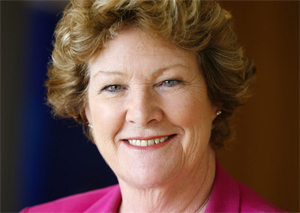Minister for Health
Minister for Medical Research
Monday, November 5th, 2012

When thinking about innovation and ways to transform how health care is delivered to the patients of today and tomorrow, the importance and growing potential of e-Health springs to mind.
In Opposition and now as Minister for Health and Minister for Medical Research I am absolutely convinced of the enormous gains to be made using e-Health technology, whether electronic patient records, telehealth connecting clinicians in remote settings, managing assets and other important clinical information and governance arrangements.
My years in Opposition did much to foster my knowledge, understanding and passion for the health system and I had the rewarding opportunity to meet with leaders in health care to discuss both challenges and future possibilities.
In 2007, as NSW Shadow Minister for Health, I was humbled to be invited to speak at Hewlett Packard’s Health and Life Sciences Symposium. Hosted at San Diego, the conference connected specialists in the e-Health field from across the globe to discuss its impacts and contribution to the wider health agenda.
The conference was incredibly inspiring for an aspiring health minister. While many there were caught up in the gadgetry, I found myself thinking a lot of about the experiences of patients back home and how they needed to be improved by advancements in technology.
Now, the NSW health system boasts one of the largest information and communication technology (ICT) portfolios of any government agency or corporate organisation in this country.
ICT has an important role to play in the delivery of health services; whether in acute hospital care, preventative health, patient self-care and those treatments provided in a range of health care settings – in a patient’s home, in the community, a private or not-for-profit facility or through the public health system.
And these services will be delivered by a range of health professionals, including those of you reading who hope to enter these fields.
For many years, I have been committed to enhancing e-Health services in this state as it is these very services that put the patient at the forefront while boosting contemporary methods of care.
NSW Health will spend more than $1.5 billion over the next 10 years on ICT to improve both care and patient outcomes across the state.
We’ve achieved a lot in this space in the past 12-18 months and are setting the foundations to do great things for the benefit of patients in the future.
We have developed numerous innovative e-Health programs across the health system including:
These are not future ambitions. These are services being utilised today to ensure our patients are not just well-cared for but well-informed and connected to health services.
As the Minister for Health, I want to see these initiatives driving better performance in our state’s hospitals – leading to better outcomes for patients and their families.
Telehealth remains a particular passion of mine. From what I am seeing utilised by clinicians on the ground, it is an impressive tool and one that sees patients receiving the best possible care with treatment transcending geographical barriers.
Recently, I was in Canberra to launch the Improving Critical Care Outreach and Training in the ACT and South East NSW project.
This pilot telehealth system will connect Canberra Hospital emergency department and helicopter base with hospitals at Queanbeyan, Moruya, Batemans Bay and Cooma.
It utilises overbed cameras, microphones and speakers and has viewing monitors positioned in the resuscitation area of the Emergency Department in the NSW spoke sites. The system uses the ACT and NSW videoconferencing networks to transmit images and vital signs to the referral or hub site in the ACT.
Telehealth initiatives have become a key component of clinical care and improving access to services in NSW.
We currently have more than 600 videoconferencing locations across the state which are used for a range of services in the areas of mental health; critical and emergency care; oncology; radiology; diabetic foot care; genetic services; and, chronic disease management.
The NSW Government is committed to supporting innovative projects such as this for the benefit of patients across NSW. We currently oversee the provision of telehealth technology in a variety of health facilities across regional NSW including Goulburn, Queanbeyan, Yass, Braidwood, Crookwell, Moruya, Bega, Batemans Bay, Cooma, Pambula and Bombala.
Telehealth affords local patients the opportunity to be treated locally with the support, guidance and expertise of clinicians at tertiary teaching hospitals..
Do medical students have a role to play in the state’s e-Health agenda? Absolutely.
Starting out in politics almost two decades ago, e-Health was considered the stuff of science fiction. Now, we’re seeing its use move from the bench to the bedside for the benefit of patients.
As our tech-savvy workforce increases, we will get smarter and more innovative.
I want a resilient system but one that is flexible and able to innovate to achieve greater efficiencies.
Above all, I want a health system that can deliver the highest quality care to patients.
Health often gets lost in statistics but technology does not substitute for the high quality care provided by clinicians, rather it enhances it.
By providing both current and future clinicians with the modern tools and information they need, we are going a long way to empowering them to achieve much more for their patients.
